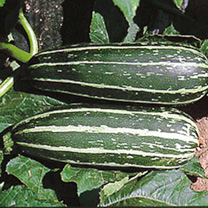How to Grow Marrows – A Guide to Growing Marrows
 Marrows are cucurbits (the same family as courgettes, squash and cucumbers). There is almost no difference betrween marrows and courgettes – just leave a courgette to grow and you have a marrow. The difference is the varieties are bred for purpose.
Marrows are cucurbits (the same family as courgettes, squash and cucumbers). There is almost no difference betrween marrows and courgettes – just leave a courgette to grow and you have a marrow. The difference is the varieties are bred for purpose.
Sowing and Growing Marrow
- Marrows are cultivated in the same way as courgettes, except that the fruits are left on the plant to develop and limited to four per plant.
- They need a lot of food and water. Try growing in an old bucket, or similar, with drainage holes made in the bottom.
- Sow indoors in March–April, into 8 cm (3 inch) pots. Move plants to their final site when all risk of frost has passed.
- Outdoors, sow direct May–June.
- Sow the flat seeds with their thin sides vertical to prevent them rotting.
- Allow 75–90 cm (2½–3 feet) between plants.
- Feed the plants regularly with tomato feed once the fruits start to develop. Leave the fruits to grow on the plant and limit to four per plant.
- Provide shelter, such as large cloches, towards the end of the season.
Harvesting Marrow
- Pick at the end of the season and allow the skins to harden (as for squash).
- Marrow should store well for a few months, preferably on a slatted shelf or strung up in a net or even an old pair of tights.
Pests and Problems with Marrow
- Marrows are usually trouble free, aparts from slugs, although they can be susceptible to cucumber mosaic virus and powdery mildew.
Varieties of Marrow
- The seed suppliers have a wide variety of marrows to try.
Eating
- Unlike courgettes, the skin and seeds are not eaten.
- Try stuffed and baked, or in chutneys. Marrow was often used as a bulking ‘fruit’ in jams being fairly neutral in flavour but Marrow & Ginger Jam is delicious.



